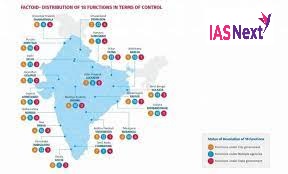CURRENT AFFAIRS
Get the most updated and recent current affair content on Padhaikaro.com
Empowering City Governments
- IAS NEXT, Lucknow
- 22, Jan 2022

Reference News:-
Urban Local Governments (along with Panchayati Raj Institutions) have been in existence in India for a long time as units of local government. They were established with the purpose of democratic decentralisation.
Even in the Covid-19 pandemic, the third-tier governments in India played a frontline role in implementing containment strategies, healthcare, quarantining and testing facilities, organising vaccination camps and maintaining the supply of essential goods and services.
However, with this, their finances have come under severe strain, forcing them to cut down expenditures and mobilise funding from various sources.
The financial empowerment of these civic bodies via higher resource availability is essential to increase their functional autonomy and strengthen their governance.
Urban Local Governments
- Beginning of Urban Empowerment: The general approach towards urban empowerment has remained piecemeal in India.
- The first intervention to understand ‘the urban’ and plan with a pan-India vision took place in the 1980s when the National Commission on Urbanisation (1988) was formed with Charles Correa as its chairperson.
- However, there were references in the earlier Five Year plans.
- The first intervention to understand ‘the urban’ and plan with a pan-India vision took place in the 1980s when the National Commission on Urbanisation (1988) was formed with Charles Correa as its chairperson.
- Other Provisions: Another important intervention was made by the 74th Amendment to the India Constitution which empowered urban local bodies to perform 18 functions listed in the 12th Schedule.
- The15th Finance Commission report on local bodies emphasised the city governance structures and the need for their financial empowerment.
Challenges
- Draining Resources: An RBI survey of 221 municipal corporations (2020-21) revealed that more than 70% of these corporations saw a decline in revenues while in contrast, their expenditure rose by almost 71.2%.
- The RBI report also highlights the limited coverage of property tax and its failure in shoring up municipal corporation revenues.
- Organisation for Economic Co-operation and Development (OECD) data also shows that India has the lowest property tax collection rate (property tax to GDP ratio) in the world.
- Lesser Functional Autonomy: During the pandemic, the leaders at national, state and district level were seen taking a call on disaster mitigation strategies, however, the heads of municipal corporations were not included in this group.
- Although, under the disaster management plan of action, cities are at the forefront to fight the pandemic, the elected leadership finds no place in them.
- The old approach of treating cities as adjuncts of State governments continues to dominate the policy paradigm.
- Decline in Grants: Octroi (a duty levied on various goods entering a town or city) was one of the major earnings of cities which was later replaced by the grants to urban local bodies (recommended by FC) based on a formula of demographic profile.
- Previously, while almost 55% of the total revenue expenditure of urban centres was met by octroi, now, the grant covers only 15% of expenditure.
- This has resulted in a vicious circle of burdening people more with taxes and further privatisation/outsourcing of the services of the municipalities. The GST further aggravated the problem.
- Structural Issues: Some of the urban local governments do not have their own building or they exist but without basic facilities like toilets, drinking water, and electricity connection.
- Moreover, there is a lack of support staff and personnel in local bodies such as secretaries, junior engineers, computer operators, and data entry operators. This affects their functioning and delivery of services.
Way Forward
- The Three F’s for City Governments: The functional autonomy of city governments must be allowed and this should happen with three F’s: the transfer of ‘functions, finances and functionaries’ to city governments. Without these, functional autonomy would be empty rhetoric.
- In the people’s plan model of Kerala, 40% of the State’s plan budget was for local bodies (directly) with a transfer of important subjects such as planning, etc.
- This paved the way for a new dimension to urban governance. Similar measures in other states are welcomed.
- Also, leadership in the cities must be elected for a term of five years. In some cities, the term of the mayor is for a year, the functionaries must be transferred to the cities with a permanent cadre.
- In the people’s plan model of Kerala, 40% of the State’s plan budget was for local bodies (directly) with a transfer of important subjects such as planning, etc.
- Grants from Income Tax Collection: The Scandinavian countries manage their functions well — from city planning to mobility to waste management by giving a chunk of the income-tax collected from citizens to city governments.
- If the large urban agglomerates in India could get a percentage of income tax for managing the affairs of urban places, it would really help improve their situation.
- Also, it was earlier recommended to give 10% of income-tax collected from the cities back to them as a direct revenue grant from the central government.
- Need of Behavioural Change for Transformation: Cities must be treated as important centres of governance, where democratic decentralisation can bring in amazing results.
- There should be transparency and adequate participation of the people.
- Cities should not be considered as entrepreneurship spaces where the sole driving force is to make them competitive to attract investments.
- They must be considered as spaces for planned development by giving adequate attention to resources.